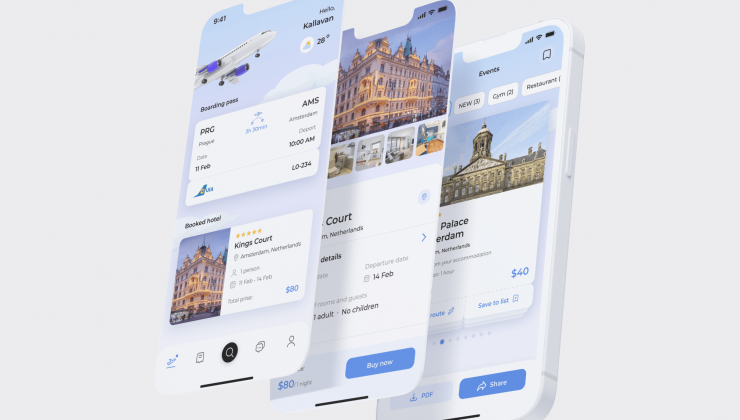Imagine this: you’ve got a brilliant idea for a digital product. Maybe it’s a marketplace, a fitness tracker, or a customer portal. The first big question pops up: should you build a mobile app or a web app?
This isn’t just a technical detail. It’s a business-critical decision that impacts your budget, user experience, time-to-market, and long-term growth strategy. In 2025, with new technologies like progressive web apps (PWAs) reshaping the landscape, every business is exploring the next new technology to invest in, making the choice more important than ever.
This guide walks you through the difference between web and mobile apps, highlights the pros and cons of each, and helps you figure out which one truly fits your goals.
What Is a Mobile App?
A mobile app is software designed to run on smartphones or tablets. These apps are typically downloaded through app stores like Apple App Store or Google Play.
Native vs Hybrid Mobile Apps
Many companies also weigh the native app vs web app approach, since choosing between the two can dramatically affect performance, costs, and long-term scalability.
- Native apps are built specifically for one platform (iOS or Android). They deliver top performance, full access to device features (camera, GPS, notifications), and a smooth user experience.
- Hybrid apps use cross-platform frameworks (like Flutter or React Native). They’re faster and cheaper to build than two separate native apps but may sacrifice some performance or platform-specific features.
App Store Distribution
One major benefit of mobile apps is discoverability through app stores. Being listed on the App Store or Google Play increases visibility, but it also means dealing with approval processes, updates, and sometimes revenue-sharing with the platform.
What Is a Web App?
A web app is accessed through a browser (think Chrome, Safari, or Firefox) without requiring installation. All users need is a link.
Browser-Based Experience
Web apps are platform-independent. They work on desktop, tablets, and mobile devices, making them a versatile choice for businesses that want broad accessibility.
Progressive Web Apps (PWA) Overview
PWAs blur the line between web and mobile apps. They’re installable like apps but run in the browser. PWAs can:
- Work offline,
- Send push notifications,
- Load fast and update instantly.
For some businesses, PWAs can replace native apps entirely, offering the best of both worlds.
Key Differences Between Mobile and Web Apps
Here’s a quick comparison to help you visualize the debate between mobile app and web app:
| Feature | Mobile App | Web App |
|---|---|---|
| Installation | Yes – downloaded from app stores and installed directly on the device | No – runs instantly in a browser, no installation needed |
| Performance | High – optimized for the device, smoother interactions, faster loading | Medium – depends on browser speed and internet connection |
| Offline access | Available – many mobile apps work fully offline once installed | Limited – mostly online; only PWAs provide some offline features |
| Updates | Store-based – users must download updates through the app store | Instant via browser – every user sees the latest version automatically |
| Development cost | Higher – especially if building separately for iOS and Android | Lower – one codebase runs across devices |
| Time to market | Longer – requires design, development, and app store approval | Faster – no approval process, immediate release possible |
What these differences mean for your business
- Installation vs instant access: If you want maximum reach and zero friction, a web app is ideal. But if brand presence on a user’s phone is important, a mobile app wins.
- Performance tradeoffs: Mobile apps shine in speed and complex interactions (think gaming, fintech, or streaming). Web apps may lag slightly but excel in accessibility.
- Offline functionality: For industries like travel, healthcare, or fitness, offline access in apps can be a game-changer. Web apps usually rely on constant connectivity unless they’re PWAs.
- Update cycles: Mobile apps give you control but at the cost of waiting for user downloads (and sometimes app store approval). Web apps update instantly for everyone, making them better for fast iterations.
- Budget and time-to-market: A native mobile app can cost 2–3 times more and take months longer. Web apps let you validate ideas quickly and scale later if needed.
In short, the difference between web and mobile apps comes down to whether you value reach, speed, and cost-efficiency (web) or performance, offline power, and deeper engagement (mobile).
Business Use Cases for Mobile Apps
You should consider a mobile app when:
- Performance and native features are critical. Apps like banking, fintech, or health trackers need access to secure hardware functions and offline capabilities.
- User experience is the top priority. Mobile apps feel more personal, with smoother navigation, push notifications, and better graphics.
- You plan long-term monetization. Mobile apps can use in-app purchases, ads, or subscription models seamlessly.
For businesses that want to save time and cost while still targeting multiple platforms, there are also hybrid app alternatives. These solutions don’t always match the performance of fully native apps but can be a smart compromise for startups and mid-sized companies.
Example: A fitness startup building an interactive workout platform may choose a native app for real-time video, offline workout downloads, and integration with wearable devices.
Business Use Cases for Web Apps
A web application vs mobile application choice leans toward web when:
- You need to launch fast. Web apps are ideal for MVPs (minimum viable products) because they’re quicker and cheaper to develop.
- Accessibility matters most. If your audience spans multiple devices (especially desktop-first users), a browser-based app ensures easy reach.
- Your budget is limited. Since web apps require only one codebase, development and maintenance are significantly more affordable.
Example: A B2B SaaS platform targeting companies worldwide may start with a web app to allow quick onboarding across devices without app store approvals.
What About Progressive Web Apps (PWA)?
PWAs combine elements of both worlds.
Pros of PWAs:
- Installable from the browser (no app store needed).
- Offline access in apps thanks to caching.
- Instant updates — no waiting for store approvals.
- Lower development costs compared to native apps.
Cons of PWAs:
- Limited access to device features (e.g., advanced Bluetooth, biometric authentication).
- Not all users know how to “install” a PWA.
- Some app stores still give more visibility to native apps.
PWAs are excellent for e-commerce, media, and content-heavy platforms where speed and accessibility matter more than deep hardware integration.
Cost Comparison: Mobile App vs Web App
One of the biggest factors in the mobile vs web development debate is cost.
Mobile App Costs
- Design and Development: Typically higher, especially if building for both iOS and Android.
- Maintenance: Continuous updates, bug fixes, and compliance with store rules add costs.
- Backend: If you need heavy APIs, push notifications, or advanced security, backend costs rise quickly.
Web App Costs
- Design and Development: Lower, since one app runs on all devices.
- Maintenance: Updates are instant and cheaper to roll out.
- Backend: Costs vary, but overall cheaper than mobile.
Rule of thumb: The cost to develop a mobile app vs web app can be 2–3 times higher, depending on complexity.
How to Decide: 3 Simple Questions
Still not sure? Ask yourself these three questions:
- Who is your audience?
- If they’re mostly mobile-first and expect polished UX, go mobile.
- If they’re desktop-heavy or global, web may be the better start.
- What’s your budget?
- Limited budget → start with a web app or PWA.
- Comfortable budget → consider mobile, especially for B2C.
- What’s the main goal of the app?
- Complex, feature-rich, long-term → mobile app.
- Fast, accessible, and scalable MVP → web app.
WEZOM’s Recommendation Approach
At WEZOM, we understand that there’s no one-size-fits-all answer when choosing between mobile and web applications. Every business has its own goals, audience, and budget. That’s why our approach is always client-first and based on deep collaboration.
Here’s how we guide you through the decision:
- Discovery workshops. We start by exploring your vision, challenges, and audience. Together, we map out your business priorities, whether that’s rapid market entry, long-term scalability, or customer engagement.
- Technical and business comparison. Using clear, easy-to-understand frameworks, we evaluate factors like cost to develop mobile app vs web app, time-to-market, performance trade-offs, and platform limitations. This gives you a transparent picture before you invest.
- Tailored recommendations. Instead of pushing a single “best” solution, we provide options:
- Native apps when performance and deep device integration are key.
- Hybrid apps when you need cross-platform coverage with balanced cost.
- PWAs when accessibility and speed-to-market are your top priorities.
- Roadmap for success. Beyond just recommending a platform, we help you design a growth path: from MVP launch to scaling, monetization strategies, and long-term maintenance.
This tailored strategy helps businesses:
- Avoid overspending on the wrong platform,
- Enter the market with confidence,
- And most importantly, build solutions that truly fit their users’ needs.
At WEZOM, our goal is simple: help you make a strategic choice that maximizes ROI and sets your project up for sustainable growth.

Conclusion
When it comes to web application vs mobile application, there’s no single “best” answer. Each path has its own strengths and limitations from offline access and performance to scalability, time-to-market, and long-term cost.
The smartest move in 2025 is to treat this decision as a strategic business choice, not just a technical one. Ask yourself:
- Who are your users and how do they prefer to engage?
- What’s your budget and growth horizon?
- Which features are mission-critical for your success?
By aligning your answers with the right technology, you’ll not only save resources but also set a strong foundation for growth and customer loyalty.
And if you’re unsure where to start you don’t have to figure it out alone. At WEZOM, we help businesses like yours explore the options, compare costs, and build a roadmap that leads to success. Together, we’ll find the solution that accelerates your launch and scales with your vision.


